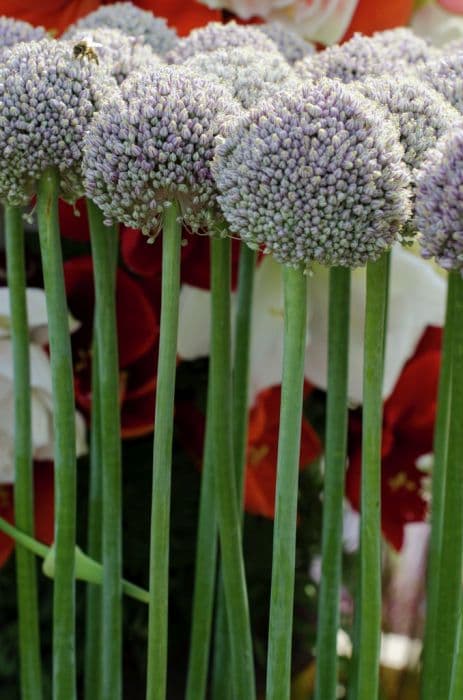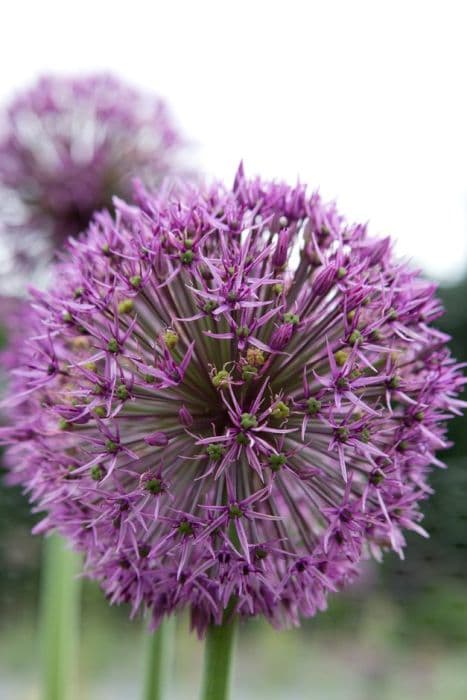Wild garlic Allium lusitanicum











ABOUT
Allium lusitanicum, commonly known as the wild garlic or broad-leaf garlic, is a perennial plant distinguished by its slender green leaves that grow in a basal rosette formation. The leaves are typically broad, flat, and have a grass-like appearance, which is why it’s often referred to as broad-leaf garlic. Its most striking feature is the spherical, densely packed cluster of small, star-shaped flowers that appear on top of a singular, leafless stalk. The flowers can vary in color but are commonly pale to bright pink or purple, creating an ornamental display. Beneath the ground, the plant has a bulb from which it derives its nutrients, and this bulb is also characteristic of the garlic and onion family. As the plant matures, it produces capsule-like fruit that releases small black seeds, allowing the plant to propagate itself. Wild garlic is known for its characteristic garlic scent, which is especially noticeable when the leaves are crushed or bruised.
About this plant
 Names
NamesFamily
Amaryllidaceae
Synonyms
Lusitanian Garlic, Portuguese Garlic
Common names
Allium lusitanicum, Allium montanum, Allium senescens subsp. montanum.
 Toxicity
ToxicityTo humans
Allium lusitanicum, also known as the wild garlic, is not commonly considered toxic to humans when consumed in typical culinary quantities. However, as with many members of the Allium family, consuming large amounts could potentially lead to gastrointestinal discomfort or irritation. In people with a sensitivity to alliums, symptoms could include stomach pain, nausea, vomiting, and diarrhea. Those with allium intolerance or an allergy to alliums should avoid consuming wild garlic.
To pets
Wild garlic can be toxic to pets, especially cats and dogs, due to compounds such as disulfides and thiosulfates which these animals cannot properly digest. Ingestion can lead to symptoms of toxicity which may include nausea, vomiting, abdominal pain, drooling, lethargy, and diarrhea. In severe cases, hemolytic anemia can occur, characterized by symptoms like pale gums, rapid breathing, elevated heart rate, weakness, or collapse. If a pet consumes wild garlic, it is important to seek veterinary attention promptly.
 Characteristics
CharacteristicsLife cycle
Perennials
Foliage type
Deciduous
Color of leaves
Green
Flower color
Pink
Height
1 foot 4 inches [40 cm]
Spread
1 foot [30 cm]
Plant type
Bulb
Hardiness zones
4
Native area
Europe
Benefits
 General Benefits
General Benefits- Edible parts: The leaves and bulbs of Allium lusitanicum, commonly known as wild garlic, can be used in cooking for their flavoring properties similar to those of cultivated garlic and onions.
- Culinary uses: Wild garlic is a popular ingredient in various traditional European cuisines, where it is used in soups, sauces, and other dishes for its unique taste.
- Aesthetic beauty: With its delicate white or pink flowers and lush green foliage, Allium lusitanicum adds visual interest and natural beauty to gardens, meadows, and wild landscapes.
- Pollinator attractant: The flowers of wild garlic are attractive to bees, butterflies, and other pollinators, supporting biodiversity and helping to pollinate other plants in the vicinity.
- Low maintenance: As a hardy, perennial plant, wild garlic tends to require minimal care once established, making it suitable for low-maintenance landscaping and wild garden design.
- Companion planting: Wild garlic can be planted alongside other garden crops to potentially help deter pests naturally due to its strong scent, benefiting organic and sustainable gardening efforts.
- Culinary diversity: Wild garlic offers a different flavor profile compared to conventional garlic and onions, contributing to culinary diversity and new taste experiences for food enthusiasts and chefs.
 Medical Properties
Medical Properties- This plant is not used for medical purposes.
 Air-purifying Qualities
Air-purifying QualitiesThis plant is not specifically known for air purifying qualities.
 Other Uses
Other Uses- Allium lusitanicum, commonly known as the "wild garlic," can be used as a natural dye, imparting a range of colors to fabrics depending on the mordant used.
- In gardening, wild garlic can serve as a companion plant, deterring pests such as aphids due to its strong smell.
- The plant can be utilized in floral arrangements, providing a unique spherical shape and a pop of white color.
- Wild garlic can be used in potpourris for its pleasant fragrance when dried.
- In the kitchen, the seed pods can be pickled and used as a garnish to add flavor and visual appeal to dishes.
- Its flowers are an attractive addition to edible landscaping, blending aesthetic appeal with culinary utility.
- The strong aroma of wild garlic can be used as a natural repellant for certain animals and insects in gardens.
- Culinary enthusiasts may use the sap as a seasoning agent, providing a subtle garlic flavor to a variety of dishes.
- In some cultures, the plant has been traditionally used in ritualistic ceremonies for its supposed spiritual properties.
- The stems of wild garlic can be woven into simple crafts or braids, which are then hung in homes for a natural fragrance.
Interesting Facts
 Feng Shui
Feng ShuiThe plant Allium lusitanicum, commonly known as the Portuguese garlic, is not used in Feng Shui practice.
 Zodiac Sign Compitability
Zodiac Sign CompitabilityThe plant Portuguese garlic is not used in astrology practice.
 Plant Symbolism
Plant Symbolism- Unity: Alliums, including species like Allium lusitanicum, are often used in floral arrangements to symbolize unity due to their globular clusters of flowers that create a visual impression of many parts forming a whole.
- Patience: The Allium lusitanicum, commonly known as the "Lavender Mountain Lily," takes time to grow and blossom, much like the virtue of patience.
- Humility: Despite its striking appearance, this unassuming flower can represent humility, growing without demanding attention and blending into its natural surroundings.
- Prosperity: The full, round shape of the Lavender Mountain Lily's flower heads can symbolize abundance and prosperity, echoing the fullness of wealth and well-being.
- Good Fortune: In some cultures, allium flowers including the Lavender Mountain Lily, are believed to bring good luck, due to their structural perfection and longevity.
 Water
WaterThe Allium lusitanicum, commonly known as the Portuguese allium, should be watered moderately to maintain moist but not waterlogged soil. During the growing season, water the plant every one to two weeks with about 1 gallon per square foot of soil, adjusting for rainfall and temperature. It's important not to overwater, as this can lead to bulb and root rot. During the dormant season, reduce watering significantly, allowing the soil to dry out between waterings.
 Light
LightThe Portuguese allium thrives best in full sun to partial shade conditions. It should be planted in a spot where it can receive at least six hours of direct sunlight daily. However, in regions with very hot summers, some afternoon shade can help protect the plant from excessive heat.
 Temperature
TemperaturePortuguese allium prefers a temperate climate with ideal growth conditions between 60 to 70 degrees Fahrenheit. They are cold-hardy and can survive winter temperatures down to 20 degrees Fahrenheit, but they may not do well in prolonged temperatures over 90 degrees Fahrenheit, which could stress the plant.
 Pruning
PruningPruning the Portuguese allium is not typically necessary, but spent flowers can be deadheaded after blooming to maintain a neat appearance and prevent self-seeding. If desired, foliage can be cut back only after it has turned yellow and died back naturally, usually in late summer or fall. This helps to direct energy back to the bulb for next year's growth.
 Cleaning
CleaningAs needed
 Soil
SoilThe wild chive prefers well-draining soil with a mix of loam and sand, with added organic matter like compost. The ideal soil pH should be between 6.0 and 7.0 for optimal growth.
 Repotting
RepottingWild chive does not require frequent repotting and can be done every 2-3 years unless the plant outgrows its pot or the soil becomes exhausted.
 Humidity & Misting
Humidity & MistingWild chive thrives in average room humidity and does not require any special humidity conditions.
 Suitable locations
Suitable locationsIndoor
Provide sun, well-draining soil, and occasional water.
Outdoor
Plant in sun, in well-draining soil, water sparingly.
Hardiness zone
Wild chive is suitable for 4-8 USDA hardiness zones.
 Life cycle
Life cycleAllium lusitanicum, commonly known as Lambley's onion, begins its life cycle with seed germination, which is dependent on the appropriate temperature and soil conditions. After germination, the seedling develops a root system and foliage in the form of narrow lance-shaped leaves. As it matures, Lambley's onion forms a bulb that serves as an energy reserve and enables the plant to survive adverse conditions. Following the vegetative stage, the plant enters the reproductive phase, producing tall flower stalks topped with spherical clusters of star-shaped flowers, typically in the summer. After pollination, which is often assisted by insects, the flowers develop into seed capsules containing black seeds, completing the cycle when these seeds are dispersed and ready to germinate into new plants. The plant may also reproduce vegetatively through bulb offsets, ensuring its persistence in suitable habitats.
 Propogation
PropogationPropogation time
Spring to summer
The most popular method of propagating Allium lusitanicum, commonly known as the Wild Chive, is through seed sowing. Seeds are usually sown in the spring in trays with potting mix. They require exposure to light for germination, so they should only be lightly covered with soil or simply pressed into the surface. After sowing, the tray should be kept moist but not waterlogged, and placed in a warm, sunny location. Germination can be slow, sometimes taking a few weeks. Once the seedlings are large enough to handle, they should be transplanted into individual pots and then later moved to their final position in the garden once they have established a strong root system.









